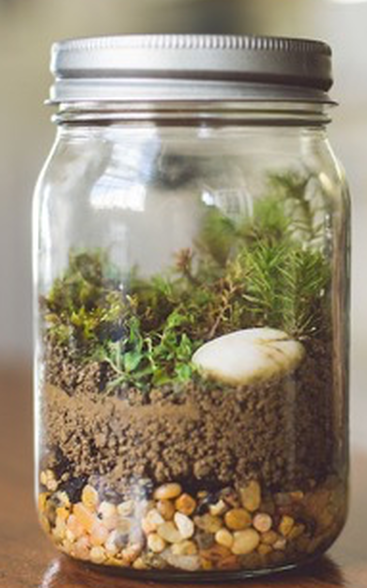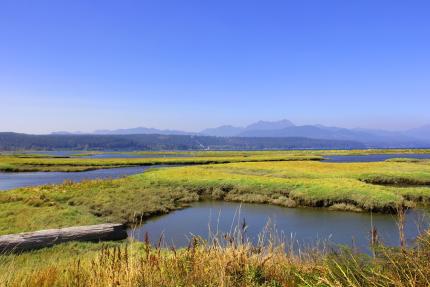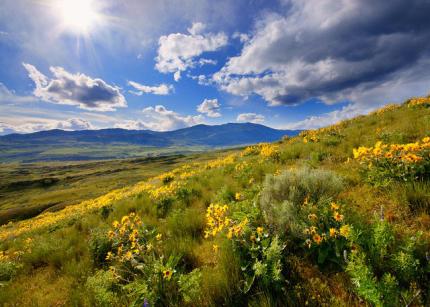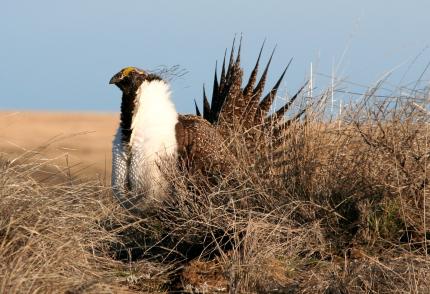Healthy ecosystems provide habitat for wildlife, and clean water and air for people. Think about the areas you have visited in Washington. Grab a notebook and pencil, and write down some examples of places you've been that were:
- Dry and hot, with only small shrubs for plants
- Full of tall trees and lots of different plants
- Along a river or stream
- Where a freshwater stream flows into the ocean
- On a beach along the coast or Puget Sound
- Up in the mountains with rocky slopes
These are all examples of different ecosystems found in Washington. Washington has a tremendous diversity of ecosystems, including prairies, wetlands, estuaries, rainforests, shrubsteppe, marine waters, and grasslands. In addition, our state is home to two ecosystem types found nowhere else on the planet: the Olympic rainforest and the scablands of the Columbia Plateau.
An ecosystem is a community of organisms (living things) interacting with their surroundings. The term ecosystem can be used to describe areas that range in size. For example, a small puddle of water, your neighborhood, the Pacific Ocean, and planet Earth can all be considered ecosystems!
An ecoregion is an area where ecosystems are generally similar in geology, landforms, soils, vegetation, climate, land use, wildlife, and water. Washington has nine ecoregions as shown in the map below.
Which ecoregion do you live in? Learn more about each ecoregion and see a detailed map on the Environmental Protection Agency website.
Materials
- Ecoregions in Washington map (PDF) (Courtesy of Environmental Protection Agency)
- Watershed search (PDF) (Courtesy of Padilla Bay National Estuarine Research Reserve)
- Estuary crossword & word search (PDF) (Courtesy of Padilla Bay National Estuarine Research Reserve)
- High tide & low tide scavenger hunt (PDF) (Courtesy of Padilla Bay National Estuarine Research Reserve)
- WaterLife: Where Rivers Meet the Sea (PDF) activity book (Courtesy of NOAA)
- Wetlands booklet (PDF) (Courtesy of the Washington State Department of Ecology)
- Shrubsteppe habitat guide (PDF)
- Sage-grouse house coloring sheets (PDF)
- Ponderosa pine identification (PDF)
What makes a healthy ecosystem?
Healthy, functioning ecosystems give us clean water and air. Ecosystems survive and thrive when biotic and abiotic things work together in balance.
- Abiotic (Non-living things): Air, water, sunlight, nutrients, and temperature
- Biotic (Living things): Plants, animals, fungi, and people
Plants, animals, weather, and bacteria each play an important role in an ecosystem. Plants are producers and make food and oxygen for animals. As consumers, animals eat plants and other animals, and give off carbon dioxide for plants to survive. Bacteria living in the soil break down dead plants and animals and turn them into minerals that help plants grow.
Watch the 5-minute video below to learn more about what makes a healthy ecosystem.
Activity: Make your own terrarium ecosystem
A terrarium is a closed environment of plants and animals that can show how an ecosystem works. With the right balance, once the jar is closed, the plant uses the water, nutrients from the soil, and sunlight to survive. When the plant sheds leaves, microorganisms break them down and add nutrients to the soil. In this activity, you will create a wet ecosystem with moss and water.

Gather your materials:
- Large glass jar with a lid
- Mesh (a piece slightly wider than mouth of jar)
- Scissors
- Rocks or gravel
- Activated carbon (Available at pet stores)
- Spray bottle of water
- Moss and small plants growing in soil
- Extra soil
- Spoon
Instructions:
- Add a 1-inch layer of rocks in the jar.
- Add a 1-inch layer of activated carbon over the rocks.
- Cut a circle of mesh slightly wider than the inside of the jar.
- Place the circle of mesh on top of the carbon.
- Use a spoon to add a 2-inch layer of soil on top of the mesh.
- Add the moss and plants.
- Water the plants generously using a spray bottle.
- Close the lid tightly.
- Watch the ecosystem over time and make adjustments as you see necessary until the balance is just right!
Riparian areas
Riparian areas include the water and surrounding plants along an active water source such as a river or stream. Grasslands, wetlands, marshes, forests, canyons, mountains, and even desert areas can have riparian areas!
Watch the video below to learn what creatures depend on riparian areas.
Activity: Waterflow experiment
Healthy riparian areas help move water slowly, allowing it to soak deep into the banks which act like giant sponges. During periods of low waterflow, river banks release water, which helps keep plants and animals alive.
Gather your materials:
- Measuring cup
- Several flat-bottomed sponges
- Cookie sheet
- Pan (Needs to be wide enough to accommodate the narrow end of cookie sheet)
Instructions:
First, simulate an unhealthy riparian area.
- Lay dry sponges end to end in two rows the length of the cookie sheet with about 2 inches of space between the rows.
- Place the end of the cookie sheet in the pan, and hold the opposite end at a low angle.
- Gradually pour a cup of water down the trough between the sponge rows. Some water should seep into the sponges, but most should wash into the pan.
- Measure how much water is in the pan.
Now, simulate a healthy riparian area.
- Cut sponges into wedges.
- Lay pre-trimmed dry sponges in two parallel rows, but this time arrange them in a series of several curves.
- Gradually pour a cup of water down the trough and measure the amount that makes it to the pan. This time there should be much less water in the pan because the healthy riparian system has soaked up water into its banks.
South Sound Prairies
Once common in the South Puget Sound region, habitats such as prairies and oak woodlands are now almost gone, with just 3% of original prairies remaining. Prairies and oak woodlands provide important habitat for wildflowers, butterflies, and birds. One of the rarest ecosystems in the country, these prairies were created by glaciers 15,000 years ago, which left behind gravelly soils.
Watch this 4-minute video for a closer look at South Puget Sound prairies.
Threatened & endangered species of prairies
South Sound prairies are also home to a variety of threatened and endangered species that in many cases are found no where else in the world. Here are some examples of at-risk species that depend on South Sound prairie habitat:
Birds
Butterflies
Mammals
Plants
Sustainability in Prisons Project
The Taylor's Checkerspot butterfly was listed as federally endangered in 2013. To increase their populations, WDFW works with the Oregon Zoo and the Sustainability in Prisons Project (SPP) to raise butterfly larvae and then release them into the wild. The program's butterfly technicians work year-round to breed and raise the butterflies at every life stage. Learn more on the SPP's Taylor's Checkerspot butterfly program page.
Using fire to protect prairies
Native Americans maintained these grassy plains for thousands of years using fire to keep the surrounding forests at a distance so that tribes could harvest wildflowers and bulbs. This land management also cleared areas of crowded trees, undergrowth, and pests, which made space for new growth and wildlife. Learn more about Native American's use of fire to enrich and protect ecosystems in this article from Crosscut.
The Washington Department of Fish and Wildlife (WDFW) manages over a million acres of public land around the state, including the Scatter Creek and West Rocky Prairie wildlife areas that are home to South Sound prairie habitat. Regular prescribed fires are important to maintain the unique South Sound prairie ecosystem. Learn more about how WDFW uses prescribed fire to preserve our state's natural landscapes in this interactive storymap.
For even more information about South Sound Prairies, watch this 15-minute documentary produced by students from The Evergreen State College.
Activity: Create a prairie mural
As a grassland ecosystem, the main vegetation of prairies is grass. However, a wide variety of other plant and animal species are also found on prairie habitat. Show the diversity of plant and animal species that use prairie habitat by creating your own ecosystem mural.
Gather your materials:
- Large piece of butcher paper, or multiple pieces of construction paper taped together
- Scissors
- Crayons, colored pencils, or markers
- Glue or tape
- Nature magazines or access to computer with printer
Instructions:
- Lay out the large piece of butcher paper or taped construction paper on a table.
- Draw or cut out pictures of plants from magazines or the internet that look like they would grow in a prairie. If you need some ideas, visit the Washington Native Plant Society's website to find plant lists based on location.
- Identify a mammal, bird, and butterfly species that depends on prairie habitat and add them to your mural. See the list below for ideas of what to look up. After you add at least three animals to your mural, think about if the habitat provides everything wildlife need to survive and thrive. Do you need to add anything? (Water source, food, shelter, etc.)
Prairie animals
- Birds: Streaked horned lark, American robin, tree swallow, western meadowlark, western bluebird, American kestrel, Northern harrier, Red-tailed hawk
- Butterflies: Mardon skipper, Woodland skipper, Taylor's checkerspot, Puget blue, silvery blue, western meadow fritillary, Anise swallowtail
- Reptiles & Amphibians: Pacific chorus frog, Pacific gopher snake, Northwestern garter snake, Northern alligator lizard, western fence lizard
- Mammals: Western gray squirrel, Mazama pocket gopher, Townsend's mole, black-tailed deer, coyote, red fox
Visit the South Sound Prairie website for landscape, plant, and wildlife photos.
Estuaries
In Washington, rivers begin in the mountains and water from rain, snow, and melting glaciers flows into streams. Streams gather into rivers and flow through forests, past farmland, and by cities until reaching the ocean.

An estuary is the place where fresh water from the land meets salt water of the sea. Estuaries are home to a variety of plants and animals that are specially adapted to living in a constantly changing environment. Plants and animals living in estuaries need to be able to deal with hot, dry sun during low tides, and cold, salty water during high tides.
Plants of the estuary
Three types of plants thrive in estuary habitat and turn sunlight energy into food. Phytoplankton are microscopic, free-floating plants that are eaten by many small animals. Eelgrass is a flowering plant that can grow 8 to 10 feet tall and provides habitat for many tiny animals that live on its blades. The third type of plant is algae, which can come in many shapes and sizes.
Animals of the estuary
An estuary can serve as a home, nursery, or rest stop for many animals. Some species like oysters, clams, worms, and snails spend their whole lives in estuaries. Meanwhile, salmon use estuaries as a nursery on their journey from the river to the sea. Young salmon find shelter and food in estuaries while they adjust to salty ocean water. Migrating birds use estuaries for a rest stop on their long migration trips and feed on estuary plants or small fish and shellfish.
Activity: Watershed search
Familiarize yourself with Washington's rivers and estuaries by completing a watershed map.
Gather your materials
- Watershed search instructions & map (PDF)
- Colored pencils, crayons, or markers (You will need blue, green, red, and black)
Instructions
Follow the directions with the accompanying map.
Activity: High tide & low tide scavenger hunt
If you live in an area close to an estuary, plan a field trip with your family to explore the area where freshwater from a river meets salt water of the sea. If you have visited the ocean before, you might remember that water levels change throughout the day. High tide is when the water level is at its highest, and low tide is when the water level is at its lowest. There are two periods of high tide and two periods of low tide every day. All together, this is called the tidal cycle.
Gather your materials
- High tide & low tide scavenger hunt (PDF)
- Pen or pencil
- Water, sunscreen, snacks, camera
Instructions
- After picking a place to visit, find out if you will experience a high tide or low tide by visiting NOAA's website.
- Complete your scavenger hunt based on what type of tide is occurring at the place you visit.
- Take a photo of your adventure and share it with us!
Shrubsteppe
The Intermountain West is the part of the country between the Rocky Mountains and the Cascade Mountains and has mountains, rolling plains, rivers, and lakes. Washington is unique because it is split down the middle by the Cascade Mountains. Western Washington is near the ocean, so it is more wet and rainy, while Eastern Washington is part of the Intermountain West and is much drier with more extreme temperatures. Eastern Washington is also home to an ecosystem called the shrubsteppe.

Shrubsteppe is a type of habitat that is very dry and has few trees. With rolling grasslands dotted with shrubs like sagebrush, rabbitbrush, bitterbrush, and other plants including bunchgrasses and beautiful wildflowers. A wide variety species of wildlife live in the shrubsteppe. In fact, some species live only in the shrubsteppe and nowhere else! You will learn about one of these species in the next activity.
Review the shrubsteppe habitat guide (PDF) to see pictures of landscapes, plants, and maps. Explore what other plants live in shrubsteppe habitat on the Washington Native Plant Society's website.
Vocabulary words
- Arid: Very dry; having very little rain
- Biogeography: The study of where plants and animals live across very large landscapes
- Intermountain West: The area of the United States between the Rocky Mountains and the Cascade Mountains
- Shrubsteppe: An arid ecosystem that is made out of grasslands dotted with sagebrush, rabbitbrush, bitterbrush, bunchgrass, and wildflowers
Activity: Exploring biogeography
Biogeography is the study of where plants and animals live across very large landscapes. As you have learned, an ecosystem is comprised of all the living things, plants, and animals, that are living within a specific area. Shrubsteppe habitat is an arid ecosystem of grasslands dotted with shrubs. In this activity, you will explore why the shrubsteppe is so unique.
Gather your materials
- Shrubsteppe habitat guide (PDF) (You will need to print a map.)
- Pen or pencil
- Markers, crayons, or colored pencils
Instructions
- Print the Intermountain West map.
- Label the states that are within the Intermountain West.
- Review the shrubsteppe habitat distribution in Washington map.
- On your printed map, use a colored pencil or marker to color in the locations where shrubsteppe habitat occurs in Washington.
- On your printed map, mark the location of your home with a star.
- Look at your completed map and review the following questions:
- Do you live in the Intermountain West or near the shrubsteppe?
- If you don’t live near the Intermountain West, can you estimate how far away you live?
- If you do live in the Intermountain West, how far away is your home from shrubsteppe habitat?
- Is the shrubsteppe outside of your city or town, across the street, or in your backyard?
- Describe how the habitat and climate of the shrubsteppe is different from the coastal environment of Western Washington.
Bonus activity for high schoolers: Study the shrubsteppe habitat decline map and compare historic and current shrubsteppe habitat distribution in Washington. What differences do you see? Research the reasons behind Washington’s shrinking shrubsteppe range. Learn more about shrubsteppe ecosystems on the U.S. Fish and Wildlife's website.
Activity: Sage grouse house
Greater sage-grouse are one of the wildlife species found nowhere else in the world except within the shrubsteppe ecosystem. Sage-grouse depend on sagebrush plants to survive. In winter months, grouse eat sagebrush leaves. In the springtime, females make their nests beneath the sagebrush's protective cover. These special birds rely on the shrubsteppe their entire lives.

Sagebrush plants can be thought of as “sage-grouse houses” because they provide protection and cover for incubating eggs and grouse chicks when they hatch. Just like human homes, a sage-grouse house needs a roof and walls to be a complete and safe shelter. For sage-grouse, the roof is made out of the sagebrush plant – it provides cover from rain, snow, and the hot sun. The walls are made out of native grass species that encircle the outside of the sagebrush plant and keep out wind and dust. Both the roof and walls provide visual protection from predators who might target the chicks for a meal.
Healthy shrubsteppe ecosystems are important for the survival of greater sage-grouse and other wildlife species living in the shrubsteppe.
Gather your materials
- Sage grouse house coloring sheets (PDF)
- Markers, crayons, or colored pencils
Instructions
- Watch this 7-minute video, Thunder Feathers: the Life of the Greater Sage Grouse. While this video was made in Wyoming, everything you see also occurs in the shrubsteppe of Eastern Washington!
- Pay close attention to how the sage-grouse interact with sagebrush plants.
- Pause the video at 3:00 and try to find the female sage-grouse. Notice how the mother grouse is camouflaged and protected insider her sage-grouse house.
- Using what you observed in the video, use your markers or crayons to complete the sage-grouse house coloring sheets (PDF). Draw and color the missing habitat components.
Questions for discussion or writing
- How did the sage-grouse interact with sagebrush plants? How many ways did you see the grouse using the sagebrush? Did you see them sitting on it, eating it, or sleeping under it?
- Look at your completed coloring sheet. Talk about what parts of the sage-grouse house were missing, and what you added with your drawing skills. Did you add a roof (the sagebrush)? Did you add the walls (the grasses)? What else did you add to create a complete house?
- Compare your human home to the sage grouse house. What is similar and what is different?
Extra learning opportunities
- Watch the National Geographic Documentary The Greater Sage-Grouse with your family.
- Explore the Sage Grouse Initiative website to learn more about sage-grouse and see all the places they live. Sage-grouse live mostly, but not entirely, within the Intermountain West. Where do you notice the Intermountain West and sage-grouse overlapping? Where do they not overlap?
- What are things that people could do to help shrubsteppe andage-grouse? Brainstorm and discuss three ideas of things you could do to help.
Ponderosa pine woodlands
The Ponderosa pine tree is the most widely distributed pine in North America, and is a key species in woodland habitats in Eastern Washington. This tree species can withstand long periods of dry weather (drought), and are usually widely spaced with herbs, grasses, and shrubs growing underneath.
Watch this 3-minute video by habitat biologist Renee Kinnick to learn how to identify a Ponderosa pine.
Activity: Explore public lands
Plan a field trip with your family to a wildlife area near you to explore different habitats. WDFW manages several wildlife areas you can explore in Eastern Washington that have Ponderosa pine woodland habitat, as well as shrubsteppe and riparian.
- Located primarily in Chelan County
- Features shrubsteppe, Ponderosa pine, and riparian habitats
- Wildlife species include eagles, migratory birds, mule deer, bighorn sheep, coyotes, and waterfowl
- Spans 17,000 acres in Columbia and Garfield counties
- Features grassland, riparian, Ponderosa pine, and shrubsteppe habitats
- Wildlife species include: Elk, deer, bighorn sheep, turkey, black bear, and birds
- Located in the Methow River watershed in the western half of Okanogan County
- Features shrubsteppe, grasslands, and Ponderosa pine habitats
- Wildlife species include mule deer, songbirds, elk, and birds of prey
Gather your materials
- Ponderosa Pine identification (PDF)
- Water, sunscreen, snacks, camera, phone
- Notebook and pencil for observations
Instructions
- Find a place to go that will have a habitat that you learned about this week. If possible, try to go to a place that might have Ponderosa pines so you can practice your identification skills.
- Take pictures of plant and wildlife species. You can use iNaturalist to identify them.
- Detail your observations in a notebook. What's the weather like? What sounds do you hear? What plants are most noticeable? Do you see any evidence of wildlife?
- Use the Ponderosa pine identification to try and find this tree species.